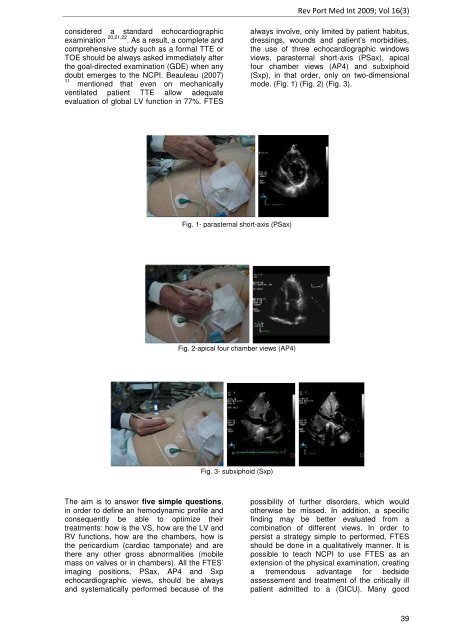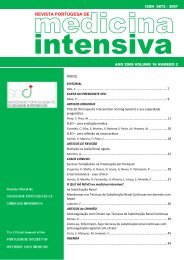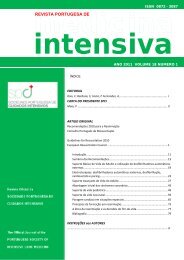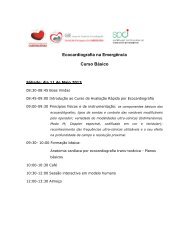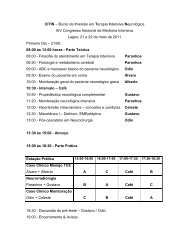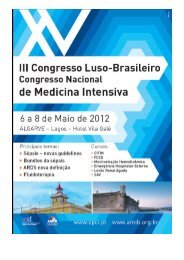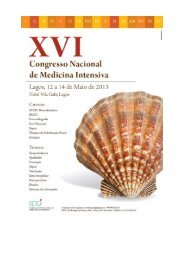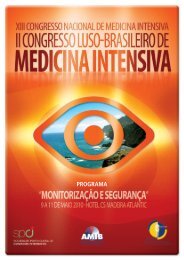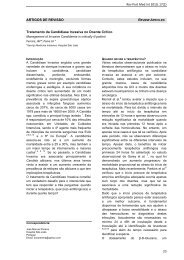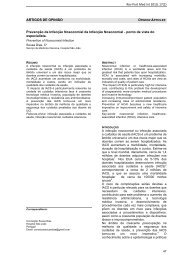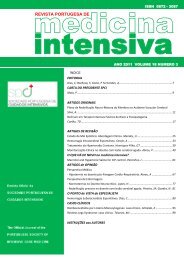Dezembro de 2009 - Vol 16 numero 3 - Sociedade Portuguesa de ...
Dezembro de 2009 - Vol 16 numero 3 - Sociedade Portuguesa de ...
Dezembro de 2009 - Vol 16 numero 3 - Sociedade Portuguesa de ...
You also want an ePaper? Increase the reach of your titles
YUMPU automatically turns print PDFs into web optimized ePapers that Google loves.
Rev Port Med Int <strong>2009</strong>; <strong>Vol</strong> <strong>16</strong>(3)<br />
consi<strong>de</strong>red a standard echocardiographic<br />
examination 20,21,22 . As a result, a complete and<br />
comprehensive study such as a formal TTE or<br />
TOE should be always asked immediately after<br />
the goal-directed examination (GDE) when any<br />
doubt emerges to the NCPI. Beauleau (2007)<br />
11<br />
mentioned that even on mechanically<br />
ventilated patient TTE allow a<strong>de</strong>quate<br />
evaluation of global LV function in 77%. FTES<br />
always involve, only limited by patient habitus,<br />
dressings, wounds and patient’s morbidities,<br />
the use of three echocardiographic windows<br />
views, parasternal short-axis (PSax), apical<br />
four chamber views (AP4) and subxiphoid<br />
(Sxp), in that or<strong>de</strong>r, only on two-dimensional<br />
mo<strong>de</strong>. (Fig. 1) (Fig. 2) (Fig. 3).<br />
Fig. 1- parasternal short-axis (PSax)<br />
Fig. 2-apical four chamber views (AP4)<br />
Fig. 3- subxiphoid (Sxp)<br />
The aim is to answer five simple questions,<br />
in or<strong>de</strong>r to <strong>de</strong>fine an hemodynamic profile and<br />
consequently be able to optimize their<br />
treatments: how is the VS, how are the LV and<br />
RV functions, how are the chambers, how is<br />
the pericardium (cardiac tamponate) and are<br />
there any other gross abnormalities (mobile<br />
mass on valves or in chambers). All the FTES’<br />
imaging positions, PSax, AP4 and Sxp<br />
echocardiographic views, should be always<br />
and systematically performed because of the<br />
possibility of further disor<strong>de</strong>rs, which would<br />
otherwise be missed. In addition, a specific<br />
finding may be better evaluated from a<br />
combination of different views. In or<strong>de</strong>r to<br />
persist a strategy simple to performed, FTES<br />
should be done in a qualitatively manner. It is<br />
possible to teach NCPI to use FTES as an<br />
extension of the physical examination, creating<br />
a tremendous advantage for bedsi<strong>de</strong><br />
assessement and treatment of the critically ill<br />
patient admitted to a (GICU). Many good<br />
39


